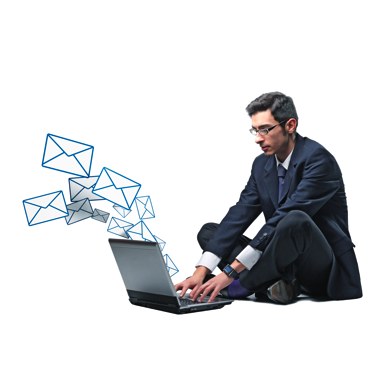

How to Write a Professional E-mail that Gets a Reply
This is a guest contribution by Jackson Nwachukwu, freelance blogger and content writer.
Who doesn’t know how to write an email? Everyone emails, don’t they? Well, let me start by telling you that there are emails and then there are professional emails.
As a freelance blogger, writer, content marketer and what have you; my best guess is that your emails are professionally intent and the primary concern each time you write an email is to get a reply on it?
It’s no-brainer e-mails are becoming the primary objects of online marketing.
Tell me one thing we do today online that does not involve writing an e-mail and you can stop reading this article right now!
Call it promotional emails, follow up emails, sells emails, update emails, mention them… they are all professional emails and factors in what we do today online. Hence, calling this a factoid is clearly an understatement; but a reality to reckon with.
Every single day that passes by bloggers, content marketers, freelance writers and so on write and send e-mails to their targeted audience but very few of these people have taken their time to look into the “how to” in e-mail writing.
In this article on USA Today, we can read about how the today’s tech savvy individuals and companies carry technology like an egg but often lose their professional touch and reputation because of one e-mail that went wrong. E-mails exchanges are going viral and have seen to be a much faster and efficient way to correspond to today’s business.
This simple mindset is critical to understanding what professional image or reputation you portray on the other side of the world each time you push that send button on your email composer.
Now I want you to do this right when you write your next email which is why I’ve listed some simple tips to writing a professional e-mail that gets replies and action plans to take. Let’s see them:
Email Writing Tip #1: Avoid the Robot Greeting
It shouldn’t be news to learn that the very first thing you should do, when writing an email, is to greet the recipient. You would be surprised how many folks get this wrong, all the time.
I’ve read a couple of emails that started off with robot greeting (a programmed and non-human greeting) and guess what, I never get to finish reading them. Emails that start off with the following greetings annoy me and it’s not just me…. They annoy every other person who may have discovered the importance of email writing:
- Hey Webmaster,
- Dear Admin,
- Hi Blog Owner (one of recent greetings I received of lately),
- Hello Admin and so on.
These are what I call the “robot greetings” and believe me they will never get you anywhere.
Action Plan: Start Off with Friendly Greetings
Study your to-be recipient and get to know what name he or she likes to be called. Start off the greeting with that name.
Greetings like “Dear Jackson” “Hello Kim” “Hi John” and so on are a much friendlier and more natural way to greet someone.
Email marketing companies like Aweber, Get Response and their likes have been huge fans of many freelance writers and internet marketers at large. A friendlier greeting is enough to get your attention reading the e-mail because you feel the e-mail is specifically meant for you.
Email Writing Tip #2: Don’t Rush into Writing
Now just because you’ve greeted the recipient does not mean you should rush into writing. Take some time to think before writing. Always remember that every e-mail sent out in your name counts and reflects the professional backbone of your business.
It’s always tempting to start writing how much you feel or care but all that may be crap so here is the thing…
Action Plan: A Proper Introduction is Sticky!
Before rushing into unveiling your objective for writing the email, take some time to think of how best to introduce yourself. If you’re writing for the first time to a client or recipient, then words like:
Hi Adam,
I am Jackson Nwachukwu, a freelance writer and professional blogger at the-name-of-your-blog or company, and then take it from there…
If you are writing to a repeat client or subscriber, pause and check the last mail you sent him. Check if there were things needed to be mentioned first before writing the new one. Chances are that, you get more attention when you follow up from the onset. Something like this can be handy:
Hello Jane,
The last mail I sent you was an intro to what you are reading today. I have just finished working on my first ebook which answers the problem we discussed and the blah blah blah …
Some people will start off by writing:
Hello John,
How are you today? Hope you are doing great in your business and then blah blah blah…
This last opening is rubbish!
When it comes to business matters treat it as one, you are not writing to your family members who need to know you care about their health or business. You’re writing to a professionally minded fellows, clients or subscribers who wants nothing but answers or solutions to their problems.
Email Writing Tip #3: Present the Meat of the E-mail
Now is the right time to present the meat of the email.
Remember you have greeted the recipient and have introduced yourself or have written a follow up line to your last email to the recipient, so go ahead and present the meat which you wish to offer. The meat is the primary purpose of writing the email.
Action Plan: Make it Clear and Concise, but not Precipitous
One thing you must always understand is that people have less time than you can imagine. It’s paramount that you make your email clear and concise because these people (including me) see time as no luxury.
Internet users are always in a hurry to read and get over it, so always have this mindset when writing an email. However, try not to be so concise or over-careful to the extent of sending emails that are broken, rough or rugged (precipitous).
If you must write an exhaustive email, then inform them at the beginning that the email will be a long one. However, to achieve results with this, you will have to make sure you offer them something meaty to keep reading.
Also be sure to use polite words like “Please” to drive home your point. A word like this means a lot and can make a huge difference.
Email Writing Tip #4: Use a Case Study or Testimonial Where Necessary
Smart bloggers, writers and marketers start marketing from the onset. There is no special time for this, after all the whole thing about writing professional emails is to solidify deals, drive sells, generate leads, build more audience and familiarity.
Case studies and testimonials have over the years proven to be driving forces that get people doing what you demand of them. It’s often said that “seeing is believing” and so use this to your advantage when writing an email that requires rapid response or reply from the recipient(s).
Action Plan: Make the Case Studies or Testimonials to Rhyme with the Tone of the Email
If you have a testimonial or case study that is subject to the email you are sending, incorporate it to rhyme with the tone of the email. This simple practice gets you results and naturally, an average reader would like to read to the end to be sure he or she learns how to benefit from the BIG picture.
Email Writing Tip #5: Close with Appealing and Polite Words
In tip #3, I mentioned “writing with polite words” to get results. You also need to do that when closing your emails.
I’ve read couple of emails where the sender closed his email on a point and blank note without considering the fact that someone took out time to read his email.
The last part of the email is always the part where you show how concerned you are about the time the reader invested in reading your email, and there is no other way to prove this other than closing the email with appealing and polite words.
This can also be your call to action if properly written…
Action Plan: Thank them for Reading
All these I’ve been saying may sound too common to some people, but believe me not everybody gets it (to their detriment)!
Always make sure to use a “Thank you” note to close your emails. This practice shows the recipient that you value the time he or she invested in reading what you sent them knowing too well they may not have asked you to send it at first. Their time is highly valuable, so thank them for it.
To add up to the “Thank you” note, you can use any of these professional and polite words to supercharge their emotions:
For Bloggers and average emails: Best regards, Sincerely, All the Best, To your Blogging Success
For freelance writers: To your Writing Success
For Content Marketers: To your Content Marketing Success
Email Writing Tip #6: Don’t Rush to Push the Send Button
Alright, you feel you’ve written a great email that will get you that anticipated replies! While you believe so much in your writing, there is still more to it.
Remember I mentioned that the emails you send out reflects your professional stand in niche where you operate, so why the rush to push the send button?
Each time you finish writing your email, let this saying come to your head “what is worth doing is worth doing well” so here is the thing…
Action Plan: Edit, Format and Proofread Before Sending
This is very important and it goes in that order.
Check for grammatical errors, wrong spellings, lines in the email that needs the reader’s eyes, links that needs to be added etc.
Also take a second look at the subject of your email to make sure it delivers at first hand the content of your email. Know that the best time to know if the subject of an email delivers on the content is when you are done with the writing.
Most times you make a promise of attaching a file but forget to do so. This is when you check all these to make sure you deliver. It’s unprofessional to send an email twice just because you forgot to attach a file or failed to proofread the email before sending.
Over to You!
Was this simple enough for you or did you learn something new today? I can’t claim to be an island of knowledge or a know-it-all which is why I gladly welcome your own tips to writing a professional email that gets reply…
Jackson Nwachukwu is a freelance blogger and content writer who writes based on his 3Es Writing Rule – exposure, experience and expertise. He shares his ideas and successes at his blog, Daily Tips Diary Dot Com.
Originally at: Blog Tips at ProBlogger
Facebook comments:
No Comments »
No comments yet.
RSS feed for comments on this post. TrackBack URL
Leave a comment
















